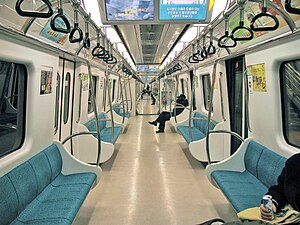
Gimhae International Airport (Korean: 김해국제공항) is located on the western end of Busan, South Korea. Opened in 1976, the airport is named after the nearby city of Gimhae. A new international terminal opened on October 31, 2007. Gimhae International Airport is the main hub for Air Busan, and a secondary hub for Asiana Airlines and Korean Air. Runway 18L/36R is used for military purposes only for Gimhae Air Base, but due to increasing traffic, there are plans to open the runway for airliners. In 2018, 17,064,613 passengers used the airport.

Innovia Metro is an automated rapid transit system manufactured by Alstom. Innovia Metro systems run on conventional metal rails and pull power from a third rail but are powered by a linear induction motor that provides traction by using magnetic force to pull on a "fourth rail" placed between the running rails. However, newer versions of the technology are available with standard electric rotary propulsion.

Maglev is a system of train transportation that is levitated along a guideway through the use of magnetic forces. By levitating, maglev trains remove the rail-to-wheel contact present in conventional railways, eliminating rolling resistance.

Seoul Subway Line 7 of the Seoul Metropolitan Subway was built from 1990 to 1996 and was completed on August 1, 2000 ; the western section between Sinpung and Onsu was put into service on February 29, 2000. This north-south line does not run through the city centre but links Gangnam directly to the northeastern districts of Seoul. In 2019, Line 7 had an annual ridership of 380 million or 1.04 million passengers per day. Although most trains run between Jangam and Seongnam, some trains short turn at Onsu station and some trains start at Dobongsan station.

Seoul Metro Corporation (Korean: 서울메트로) was a municipal-owned corporation owned by the Seoul Metropolitan Government. Established in 1970, it was, with Seoul Metropolitan Rapid Transit Corporation and Korail, one of the major operators of Seoul Metropolitan Subway. The company merged with Seoul Metropolitan Rapid Transit Corporation in 2017.

Daejeon Subway Line 1 is a subway line is located in Daejeon, South Korea. After excluding the Seoul metropolitan area, it was the fourth subway line created in South Korea, following Busan, Daegu, and Gwangju. Its line color is ● green. It is 22.6 km (14.0 mi) long with 22 stations. It is the first of five planned lines for the Daejeon Metro.

The Minsk Metro is a rapid transit system that serves Minsk, the capital of Belarus. Opened 1984 June 29, it presently consists of 3 lines and 33 stations, totaling 40.8 kilometres (25.4 mi). In 2013, the system carried 328.3 million passengers, which averages to a daily ridership of approximately 899,450.

The Busan Metro is the urban rail system operated by the Busan Transportation Corporation of Busan, South Korea. The metro network first opened in 1985 with seventeen stations, making Busan the second city in South Korea and third in the Korean Peninsula to have a metro system. The Metro itself consists of 4 numbered lines, covering 116.5 kilometres (72.4 mi) of route and serving 114 stations. Including the BGL and the Donghae Line, the network covers 205.6 kilometres (127.8 mi) of route and serving 158 stations.

Sejong or Sejong City, officially the Sejong Special Self-Governing City, is a special self-governing city and the de facto administrative capital of South Korea.

The Gyeongbu high-speed railway, also known as Gyeongbu HSR, is South Korea's first high-speed rail line from Seoul to Busan. KTX high-speed trains operate three sections of the line: on 1 April 2004, the first between a junction near Geumcheon-gu Office station, Seoul and a junction at Daejeonjochajang station north of Daejeon, and a second between a junction at Okcheon station, southeast of Daejeon, and a junction near Jicheon station, north of Daegu entered service; then on 1 November 2010, the third section, between a junction west of Daegu and Busan became operational. The missing gaps across the urban areas of Daejeon and Daegu were in construction for an expected opening in 2014, separate tracks into Seoul Station were also planned. The temporary ends of the three sections were connected to the parallel conventional Gyeongbu Line by tracks that will serve as interconnector branches upon the completion of the entire line. On 1 August 2015, construction on urban areas of Daejeon and Daegu were completed; all the sections of HSR line were connected.

Guangzhou–Shenzhen–Hong Kong Express Rail Link (XRL), also known as “Guangshengang XRL”, is a high-speed railway line that connects Beijing and Hong Kong (Kowloon) via Guangzhou and Shenzhen.

The Incheon Airport Maglev was a maglev line in South Korea that opened on 3 February 2016 and closed on 1 September 2023. It was the world's second commercially operating unmanned urban maglev line after Japan's Linimo. The trains were lighter, cutting construction costs in half. The majority of construction was completed by November 2012.

Gwangju Metro is the rapid transit system of Gwangju, South Korea, operated by the Gwangju Metropolitan Rapid Transit Corporation. The subway network first opened in 2004 with 14 stations. The Gwangju Metro consists of one line, serving 20 operational stations, and operating on 20.1 kilometres (12.5 mi) of route. It crosses both of the major rivers in Gwangju, the Yeongsan River and the Hwangryong River. Most of the system is underground, except for the sections between Sotae-Nokdong and Pyeongdong-Dosan.

Panam Station is a station of Daejeon Metro Line 1 in Panam-dong, Dong District, Daejeon, South Korea.

Jungangno Station is a station of Daejeon Metro Line 1 in Eunhang-dong, Jung District, Daejeon, South Korea.

Yongmun Station is a station of Daejeon Metro Line 1 in Yongmun-dong, Jung District, Daejeon, South Korea. It is located between Ohryong Station and Tanbang Station of Daejeon City Railway Line 1. This station is located across the Yudeung Stream from Ohryong Station. It is 7.82 kilometres (4.86 mi) away from Panam.

Government Complex, Daejeon station is a station of the Daejeon Metro Line 1 in Dunsan-dong, Seo District, Daejeon, South Korea. It is located between City Hall Station and Kalma Station of Daejeon City Railway Line 1. It is 10.76 kilometres (6.69 mi) away from Panam. On the southern side of the station are the Bank of Korea, Eulji University Hospital, Seo-gu Office, and Sunmori Park. On the north side, there are Daejeon Government Building, Chungcheong Regional Statistical Office, Daejeon Government Complex Inter-City Bus Terminal, Dusan Seonja Site and Daejeon Regional Food and Drug Administration. There are also Boramae Crossing, Bukchung Crossing, Seokgung Crossing, and Prehistoric Crossing around government ministry.

Galma station (Korean: 갈마역) is a station of the Daejeon Metro Line 1 in Galma-dong, Seo District, Daejeon, South Korea. The station is 11.51 kilometres (7.15 mi) from Panam.

Banseok station is a station of the Daejeon Metro Line 1 in Banseok-dong, Yuseong District, Daejeon, South Korea.
Daejeon Metro Line 2 is a planned street-level tram line located in Daejeon, South Korea. Opening of the line is scheduled for 2027.






















